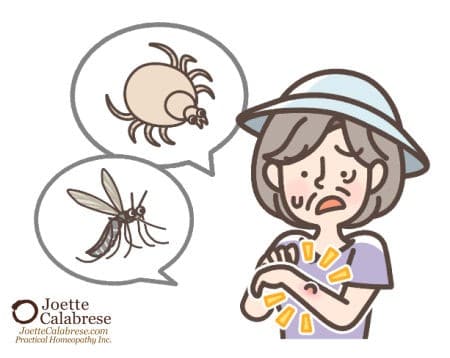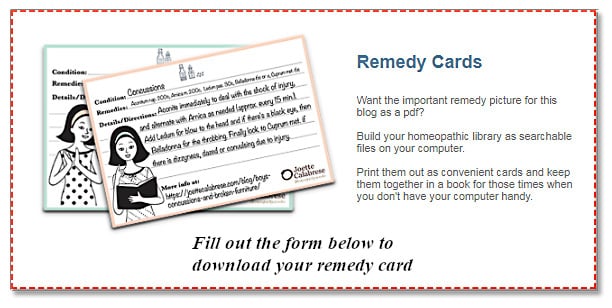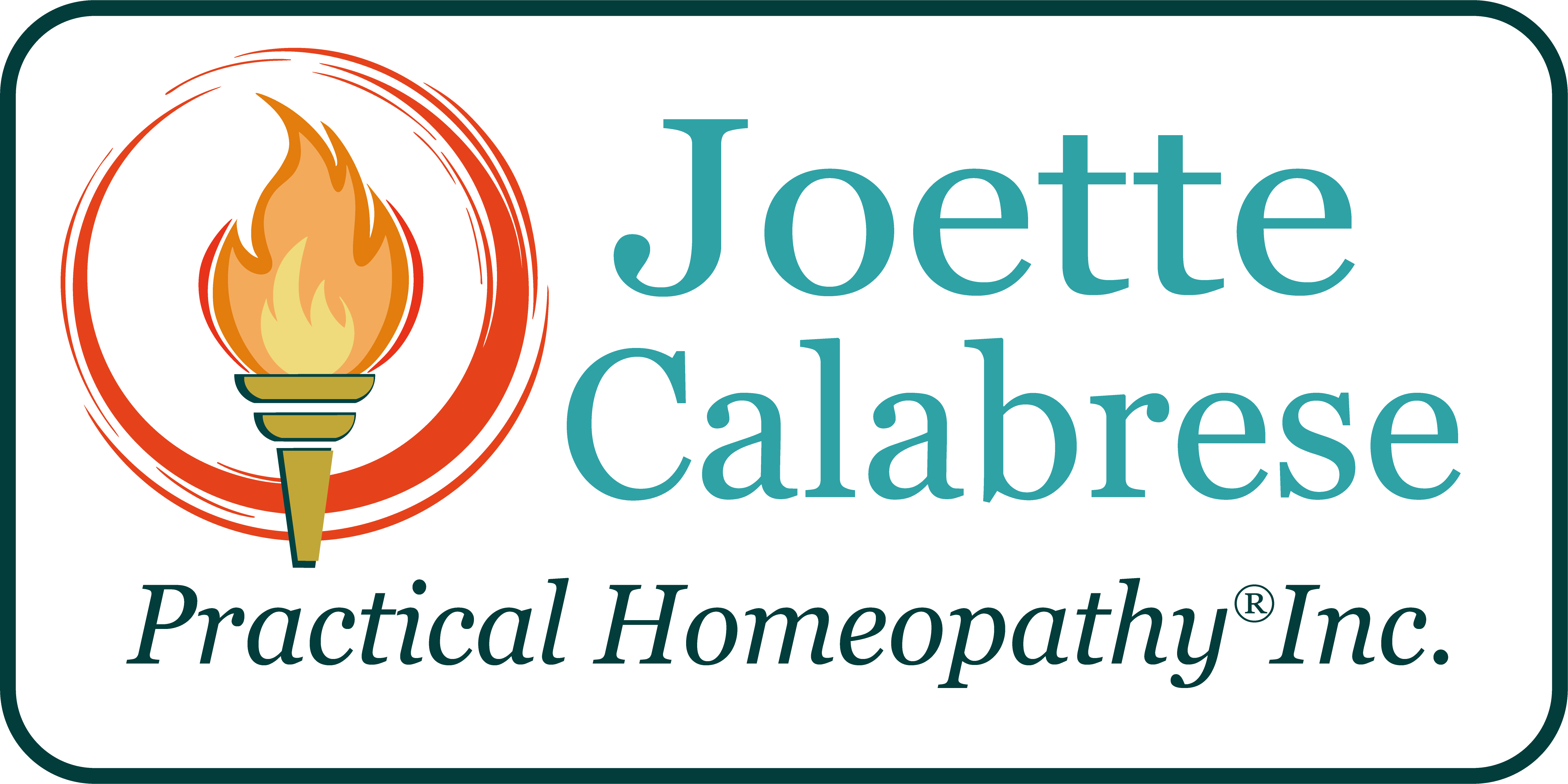You know how much I love singing, so you’ll forgive me for changing the lyrics of “Summertime and the Livin’ Is Easy.” Indeed, summertime is when I think of Ledum the most often, so doesn’t it deserve to be in the title?
My friends, let’s just cut to the chase. The next medicine we should all have in our homeopathy kits is Ledum palustre (in both 30 and 200 potencies).
I’ve discussed Ledum on several occasions before, especially for insect stings and bites — bites actually from any animals, not just insects:
- Emergency Remedy Series: Bites Make Me Itchy. You Too?
- My Top 5 Sizzling Summer Remedies
- Watch Out for the Chiggers!
Ledum is also useful for snake bites. Last week, my Mighty Members enjoyed a lengthy article I wrote containing detailed information from a graduate of The Academy of Practical Homeopathy® (and current Mastery student) who addressed a 5-foot rattlesnake’s bite on a dog’s paw … with homeopathy. Her entire community now has seen the proof that homeopathy works! It’s inspirational!
Ledum is known for addressing puncture wounds. That’s exactly what animal and insect bites are, right? So, let’s not forget Ledum’s usefulness in any type of puncture situation, especially in areas of the body that are rich in nerves (such as hands and feet).
For instance, it’s summer. Who needs shoes? Allen was out walking in his backyard when, suddenly, YEEE-OUCH! Somehow, he managed to step on a nail!
Having studied my magnum opus, The Survivalist Guide, Allen chose to employ Ledum 200, every 4 hours or so, until the puncture wound appeared very much better. Then, he continued to utilize Ledum 200, once daily for three weeks post-injury, as some literature has shown that Ledum can help guard against tetanus.
Allen also recommended Ledum to his mother, Edna, who had been suffering from rheumatism of her lower extremities. Now, while it is not considered a specific medical diagnosis, rheumatism is a common, informal term used in instances of inflammation and joint pain caused by any disease or syndrome.
Edna’s pain was — pardon the pun — nerve-wracking. She was unable to work in her garden or play with the grandkids on the swing set. Here it was summer, and she was having no fun at all — just severe pain.
While there is no particular protocol for Ledum with cases of rheumatism, it has been shown that Ledum 30 or 200 (depending on the severity), utilized twice daily, can uproot the condition over time. (Scroll down, as this week’s free Remedy Card provides this information.)
Allen bought his mom a tube of Ledum 200 and made sure she knew how to pop the appropriate number of pillules that make up one dose (as shown on each manufacturing pharmacy’s label) into her mouth and allow them to dissolve.
That’s right, Edna! It may sound too easy, but that’s what we love about homeopathy. It’s inexpensive, easy to utilize and efficacious, yet it doesn’t usher in the dangerous side effects that conventional medications can.
Another beauty of homeopathy is that there is often more than one way to shear a sheep. That’s why one should always confer with a repertory (to find common ailments and their associated medicines) and a materia medica (to read up on the characteristics of each suggested medicine).
For instance, we often think of Rhus toxicodendron for joint pain. But Ledum palustre is also a viable choice. In a nutshell, sufferers whose joints feel better from warmth generally consider Rhus tox. On the other hand, sufferers who prefer cold applications might do well to consider Ledum.
We make our choices based on the specific symptoms as they present.
Another example: Ruta graveolens is known to be especially useful in sprains of the lower extremities such as the ankle. But Ledum is well regarded as an alternative, especially when the sufferer desires to dunk their foot in cold water for pain relief.
It’s such a simple differential (cold vs. warmth), but recognizing that distinction may make all the difference!
In case you’re not yet in awe of the power of Ledum, I also have mentioned utilizing it for eye orbit injuries in Baseballs and Black Eyes and also for gout (in combination with Belladonna) in The Disease of Kings and Commoners.
But right now — summertime — we often closely identify with Ledum’s handling of tickborne diseases, most notably the hot topic of every summer, Lyme Disease. If you’ve not read these blog posts, they may interest you.
- Chronic Lyme Disease: Are You Sure About That?
- Lyme, Lyme, Lyme: Just Making Sure You Know What to Do
- Protocol for Lyme Disease Using Homeopathy
- Podcast 29 – Lyme Q & A
However, let me add this clarification. Determining which microorganism may be at play in our condition can be useful, but that’s not where we start. In Practical Homeopathy®, we first ask ourselves, “What are the symptoms?”
So, if a tick bite is causing fibromyalgia, then we use the medicine for fibromyalgia!
And now is a good time for a reminder: We’re not treating symptoms. We are doing the exact opposite of that. We are using those little gifts we call symptoms to determine which homeopathic medicines might be useful.
Certainly, fibromyalgia can come from Lyme disease, but it can also come from other sources, such as hormonal shifts, overuse and food intolerances. It matters not!
Now, if we’ve used the appropriate medicine for our symptoms — in this case, let’s say fibromyalgia and fatigue from Lyme Disease — and they are not helping, then at that point we might consider the etiology or the microorganism. But we don’t start by chasing after one of a million different microorganisms. Indeed, if we start down that rabbit hole, we will miss a cathedral of good homeopathic medicines that could successfully address the condition as its presenting.
So, I’ll say it again, when choosing our medicines, we start with the symptoms!
We don’t treat a lab result.
If a client comes to me with their blood work, I generally say, “That's useful, but put it to the side. Now, tell me what's really happening with you. Oh, there's fatigue and fibromyalgia. Then, we’ll use this medicine for fatigue and this one for fibromyalgia.” (You might be interested in How I Cured My Fibromyalgia with One Simple Medicine.)
We choose our medicines according to what is happening in real-time.
Before many sufferers began looking for alternatives to the conventional medical paradigm and discovered naturopathy and functional medicine, we didn't have this conundrum.
If a sufferer told a conventional doctor they felt fatigued all the time, he would simply tell them, “That's called chronic fatigue.”
Or if a patient went to the doctor and said, “These joints hurt right here at the thumb,” the doctor would reply, “Well, that's arthritis!”
“Every fiber in my body aches” would be answered with “That's called fibromyalgia.”
You know what I mean. Doctors simply took the description of the symptoms and couched it in a medical term. It was actually easier for me as a homeopath in those days.
But in the last 20 years, I’ve seen a significant shift with sufferers placing importance on myriad lab tests that may be useful to the naturopathic or functional paradigm but not necessarily to homeopathy. It can be. But it's not the first, secondary, or even the tertiary way we look at a condition.
So, observe symptoms carefully and appreciate the signs they provide, especially with blanket diagnoses such as Lyme Disease, chronic fatigue or adrenal fatigue. Sometimes a name can cloud our judgment when only the symptoms — what’s happening right now — are all we need to begin our research to find the most appropriate homeopathic medicine.
Enjoy summertime and pass on the good news of homeopathy!
Warmly,
P.S. Feeling a bit left out that you didn’t receive the fascinating and educational article on my student’s rattlesnake bite experience? Well, there’s one simple solution, you know. Join Joette’s Mighty Members!
My Memos to Mighty Members are extra blog posts on topics I feel more comfortable discussing in a private setting where I can be more candid (unlike in a public blog). You’ll receive a new one each week. Plus, all my previous memos are archived (so you can still learn about the rattlesnake case).
There are all sorts of extra benefits to Mighty Membership, so take a look! And remember — all my Mighties also qualify for a 10% discount on course purchases!







where can tabacum be purchased, the homeopathic formula for tobacco
You may go to the same place that where we link Ledum.
Ive tried the Argentum Nitricum with my Dog Luna who gets extremely nervous and wants to hide trying to get into closed doors during thunderstorms or fire works. I usually give a dose right before on set of the event but the 1 dose doesn’ seem to help. Ive then administered a second dose and not much better. Is there anything else you can recommend to give before I go to Vet who will probably dope my dog up to much with medication
There are a number of homeopathic medicines for this condition and they often need to be repeated every few hours during an attack and evenas a prophylactic when you know the event is forthcoming.
In order of their common usage, there’s Phosphorus 200, Aconitum 200, Coffea 200 or Ignatia 200. Read up on each and you’ll likely be able to figure it out with enough study.
Please keep informing Me ,Us , to keep us healthy 🙏❤️🙏
Thanks for all of the wonderful information. Is there a remedy for “devil’s itch” or “hell’s itch” related to sun and heat (not necessarily sunburn. symptoms are itching and pain with heat and sun exposure
Hi Joette,thank you for the wealth of information you share in this great blog. I am new to homeopathy: Can I use ledum palustre 1M instead of the 200 potency as well. I read that higher potencies are more diluted yet work on a deeper level. Not sure if this info is correct. Thank you for your reply!
The potencies I post are specific. To play around with them can confound outcomes.